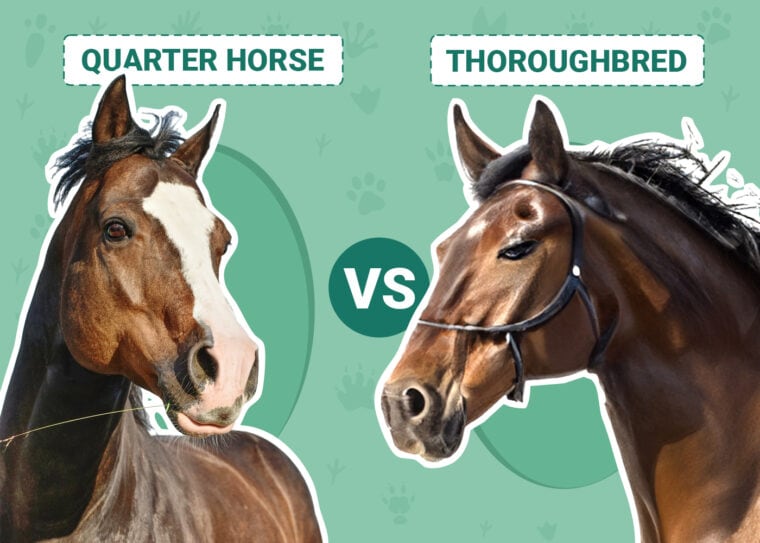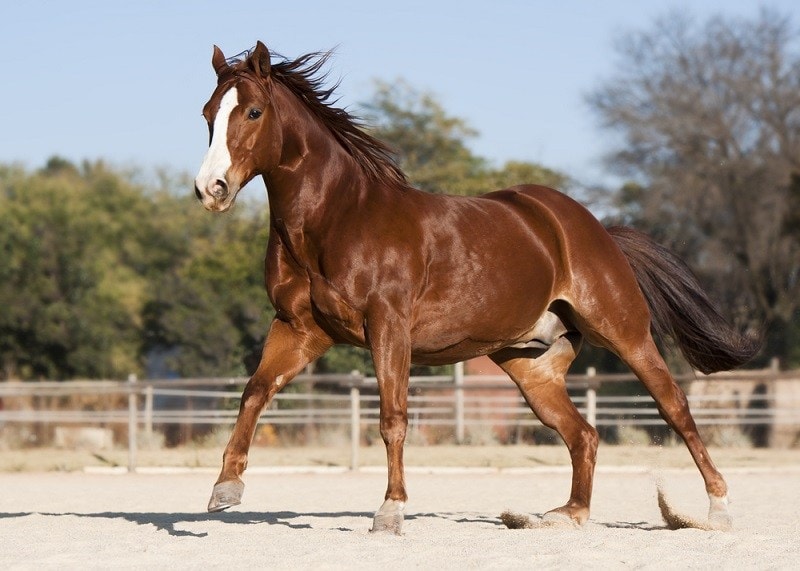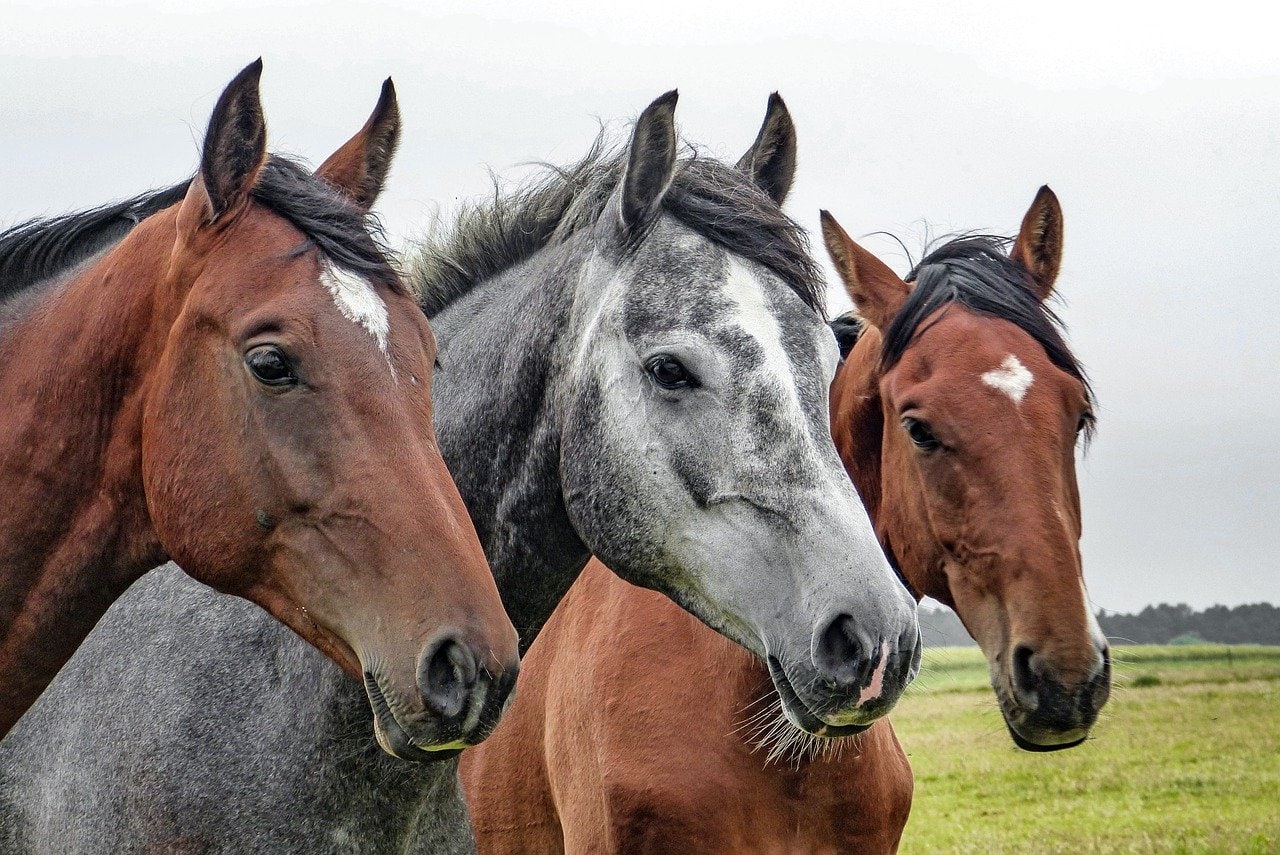
Quarter Horses and Thoroughbreds have long been considered two of the best racing horses, but they are suitable for different racing environments. Quarter Horses are ideal for jumping and short races, while Thoroughbreds excel in long-distance racing.
Despite their similar uses, Quarter Horses and Thoroughbreds are quite different and appeal to different people. For example, Quarter Horses are mellow and loving, making them great for beginners or people with children. The same cannot be said for Thoroughbreds, which are high spirited and unruly. Thoroughbreds require experienced trainers who know how to train such a spirited breed.
The personality is not the only difference between these breeds, though. To find out more about Quarter Horses and Thoroughbreds, keep reading. In this guide, we give you an overview of both breeds and help you determine which one is right for you.
Visual Differences

At a Glance
Quarter Horse Overview
The Quarter Horse has long been a popular American horse breed for short-distance racing. Due to this, they are often known for quarter-mile races, which is where they get their name. Dating back to the 1600s, the Quarter Horse was developed as a cross between a Spanish horse and an English horse. It is believed that the English horse used to breed the Quarter Horse was a Thoroughbred, making the two breeds possibly related.

Appearance
In terms of appearance, a Quarter Horse is a medium to large size horse. They are typically 56 to 64 inches tall and weigh 1,200 pounds on average. Their overall build is muscular, with a short head and broad chest. This muscle enables Quarter Horses to excel on the race track.
Their coat can come in a variety of hair colors. For example, Quarter Horses are known to have roan, chestnut, black, and brown coats, but there are quite a few more colors that they can possibly have. All the coats will be solid colored, but they will have white marks on their face and knees.
Personality
A Quarter Horse is tough to beat in terms of their personality. They are typically mellow and calm, and they are open to many new surroundings and owners. Although they may take time to settle, they are rarely aggressive and are difficult to trigger.
Additionally, they tend to be loving and affectionate to their owners. This is a great benefit if you are looking to own a horse for more than just racing purposes. You will certainly have a friend in a Quarter Horse.
Training
Due to how mellow Quarter Horses are, they are considered easy to train. In fact, this breed is a great starting horse if you are a beginner at horse training. That said, this horse is also a great choice for experts because of their strength, intelligence, and superiority in short-distance racing.
Health & Care
Generally speaking, the Quarter Horse is a healthy breed, but respiratory issues can be a concern, especially for raced individuals. If you get the proper vaccinations early in their life and exercise them properly, your horse should be able to avoid most respiratory issues.
Another common issue of Quarter Horses is dental infections. They can also experience dental overgrowth, swelling, fractures, and a variety of other oral issues. Watching your horse’s eating habits can notify you of any problems.

Other than preventative measures, Quarter Horses are known to be easy keepers in terms of health and care. Give them a good pasture or good-quality hay, and they should thrive and be happy with minimal maintenance.
History
The Quarter Horse is one of the oldest American breeds. They originated around the 1660s, when Spanish horses were crossed with English horses, which had arrived in Virginia around 1610. The horse breed became raced frequently by the late 17th century. Today, they are still bred for short-distance racing and other professional uses.
Suitable For:
Due to their mellow demeanor yet intelligent trainability, Quarter Horses are suitable for just about any horse owner. Beginners will find this to be a great horse to start out with, but experts can still use Quarter Horses for racing or enjoyment.
This breed is especially great if your home has children. Quarter Horses are rarely aggressive, meaning they are less likely to bite children than some other breeds. All around, this is a great breed that is suitable for just about anyone.
Thoroughbred Overview
Thoroughbreds are among the most popular horses used in horse racing. Dating back to 17th century Britain, this horse has long been selectively bred so they can beautifully demonstrate strength, stamina, and speed. Although this certainly is a beautiful horse, they aren’t suitable for everyone.

Appearance
Thoroughbreds typically range between 60 inches and 68 inches in height, but most are 64 inches, or 16 hands tall. They should weigh between 1,000 pounds and 1,200 pounds. Their body is incredibly athletic, making this breed perfect for long-distance racing.
Much like Quarter Horses, Thoroughbreds can come in just about every color. The most common include bay, black, brown, chestnut, or gray. Normally, any horse with multiple colors or coat patterns is not considered a Thoroughbred. However, white facial or leg markings are suitable.
Personality
Besides their athletic body, Thoroughbred horses are known to have feisty personalities. In fact, they are typically considered hot-blooded horses, meaning they are bold, intelligent, and spirited. It takes a knowledgeable and special equestrian trainer to master this breed.
If you want to get along with a Thoroughbred, you need to have confidence and experience to know how to channel their energy and excitement. Otherwise, your horse will likely feel like an overwhelming and impossible burden.
Training
Due to the Thoroughbred’s feisty personality, they can be tough to train. You need a great deal of experience and confidence to be able to master this breed. That is not because the horse is unintelligent. On the contrary, Thoroughbred horses are incredibly smart. With the right trainer, they can pick up instructions and cues quickly.
That said, you should not try to train a Thoroughbred unless you have the experience and competence to do so. Beginners will be hard pressed to successfully train this horse, especially for racing purposes.
Health & Care
Since Thoroughbreds are typically used for racing purposes, they experience high rates of health problems. This includes constipation, bleeding lungs, heart issues, small hooves, and low fertility, in addition to common respiratory and oral ailments.
If you use a Thoroughbred for leisure riding or enjoyment, they typically do not experience these severe health issues, but they can still become overweight or bored. Since these horses are used to high physical demands, you need to exercise them regularly to keep them healthy and in shape.
History
The history of Thoroughbreds dates back to the 3rd century. Through many years of selective breeding, the first general studbook was created for the breed, known as the Royal Mare at the time, under James I and Charles I. Since then, the breed has traveled all around the world, becoming one of the favorite breeds for American horse racing.
Suitable For:
Given this horse’s unruly and wild spirit, Thoroughbreds are suitable for equestrians with experience. Beginners will find this horse incredibly overwhelming and difficult to train. This could be dangerous for both the horse and the rider. Only select a Thoroughbred if you have the proper training.
Quarter Horse vs Thoroughbred: A Comparison
Now that we’ve looked at each horse individually, let’s compare them to one another to get a better understanding of how the horses differ.

Appearance
Both the Quarter Horse and Thoroughbred are incredibly similar. Amateurs may find it difficult to see the difference between these two breeds simply by looking at them. They both have somewhat compact bodies that are incredibly muscular, and they have single-colored coats. If you are interested in one horse purely because of their appearance, you will also likely enjoy the appearance of the other.
Personality
The personality is largely where the Quarter Horse and Thoroughbred differ. Thoroughbreds are feisty and unruly, whereas Quarter Horses are mellow and loving. The personality should largely determine if the Quarter Horse or Thoroughbred is right for you.
If you have no experience with horses or have children, the Quarter Horse is definitely the best option. In comparison, Thoroughbreds are ideal for professionals who want a horse for racing purposes. You can also have a Quarter Horse for professional purposes, though, with the exception of long-distance running.
Training
Interestingly, Quarter Horses and Thoroughbreds seem to interpret instructions the same way. As a result, they tend to respond to training similarly. Despite this, though, Thoroughbreds are more difficult to train simply because of their unruly nature.
Exercising
Another way that Quarter Horses and Thoroughbreds differ is in their exercising. Although both horses are athletic, Thoroughbreds need more exercise and activities than Quarter Horses. Quarter Horses do well grazing in pastures, but Thoroughbreds may need more stimulation and exercise.
Final Thoughts
The Quarter Horse and the Thoroughbred are both incredibly gorgeous, athletic, and favorites among the horse community. Still, the horses are fairly different, despite the possibility of a shared lineage and various similarities.
Quarter Horses tend to be mellow and kind while still being eager to please, hardworking, and athletic. This makes the breed ideal for just about any owner. Someone looking for a short-distance racing horse will be just as pleased with the Quarter Horse as someone looking to surprise their children with a pet horse.
Conversely, Thoroughbreds are fairly spirited, energetic, and unruly. Although they dominate the industry of horse racing, they are not the ideal horse breed for families, small children, or beginners with minimal experience in horse training.
With that in mind, Quarter Horses are right for just about anyone, except long-distance racers. If you want a horse for that purpose, select a Thoroughbred, and make sure to get an educated trainer. For any other needs, the Quarter Horse will likely be the more manageable and enjoyable horse of the two.
Featured Image Credit: Top – Vera Zinkova, Shutterstock | Bottom – rihaij, Pixabay









